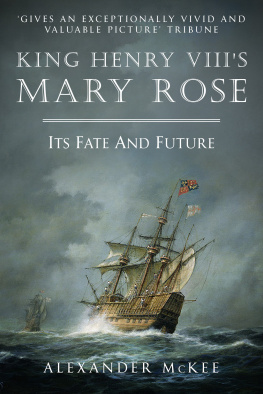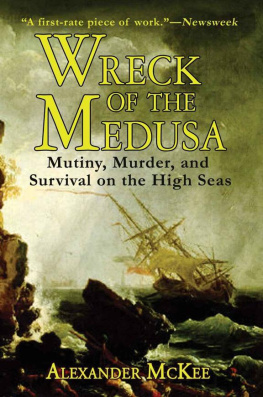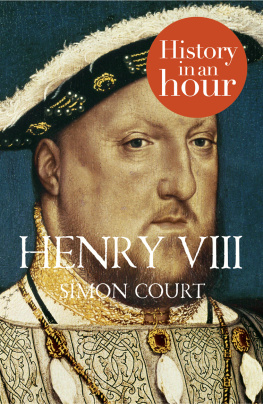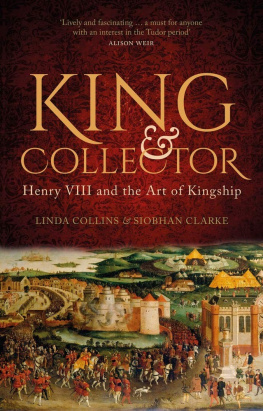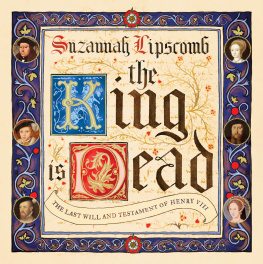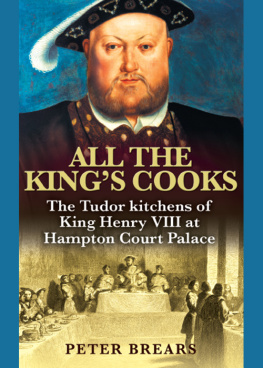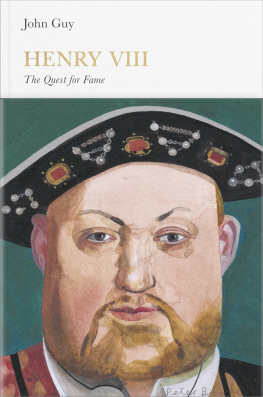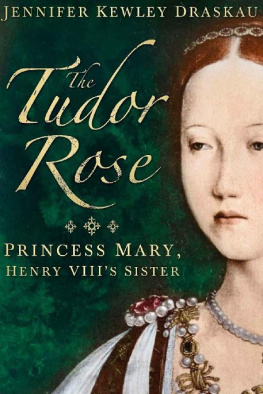King Henry VIIIs Mary Rose
Its fate and future
Alexander McKee
Copyright Alexander McKee 1973
The right of Alexander McKee to be identified as the author of this work has been asserted by him in accordance with the Copyright, Designs and Patents Act, 1988.
First published in 1973 by Souvenir Press Ltd.
This edition published in 2017 by Endeavour Press Ltd.
Table of Contents
Foreword
I cannot remember when I first heard about the fate of the Mary Rose . Probably it was as a boy, playing in the pools of the rocky foreshores at Bembridge in the Isle of Wight. The story of how the French had stormed ashore across those beaches was a well-worn item of local history (although everyone else in England always assumed that the last foreign invasion had been in 1066). The passing close inshore of the Spanish Armada under heavy English attack in 1588 had left no mark on the island, whereas some of the villages and havens wiped out by the French troops in 1545 had disappeared literally from the face of the earth and in modern times there was no trace of them. Much later, I was to comprehend exactly what it felt like to see an enemy commanding the waters immediately offshore of Portsmouth and the Wight and to watch the smoke of fires rising from the downs above Bonchurch, 405 years, almost to the day, after actual invaders had scaled those heights. The fact that the 1940 target was a radar station dive-bombed by German stukas, instead of a village and its surrounding farms fired by French soldiers in armour, made no difference to me; the experience was essentially the same and anyway both are history now. That is, we know how the story ended.
The oddest thing, I find, is that as a boy I must have passed many times directly over the remains of the Mary Rose when crossing between Portsmouth and the Wight in ferry steamers. But I did not know and nor did anyone else, for the precise site of that Tudor tragedy had long been lost when I began my search in 1965. Nor, at the start, did I suspect that the remains were buried entirely and that I was looking for an invisible wreck. But it was so, and consequently the later stages of my enquiry consisted of that rare process in what is sometimes grandly called underwater archaeology and is often merely the random collection of material from the seabed, a genuine excavation, complete with deep, straight-sided and properly tagged trenches.
Although my object is to raise the ship and the remains of that Tudor naval and military society which went down with her, I have only once, when underwater, been conscious of their nearness to me. That was when we had just, begun our first cautious examination of the buried hull and I had gone down at the end of the day, when it was night on the seabed, to check on the progress of the dig along with a score or so of ghostly fish seeking fresh morsels from the excavated clay. Then indeed I thought of the dead men lying perhaps only a few feet away and remembered that I knew only two of them by name and reputation, Sir George Carew and Roger Grenville. Even more strangely, when further progress had exposed a dead man trapped in the upper levels of the wreckage, my attitude was entirely clinical I examined his remains carefully to see if it really was one man and not just a collection of bones.
To the layman, more accustomed to reading about wrecks accidentally discovered, it may seem surprising, although to the archaeologist it is the rule, that thorough research precedes the search which precedes the excavation which in turn determines what is to be done with the site. But a structure without its context means nothing at all. As a professional historian, although only an amateur archaeologist, I knew from the first that I needed to know as much as possible about the ship itself, the sort of battle for which it was designed, the people who manned it and much general background besides, and not merely where, how and why she sank (although these questions were vital during the search phase). The Mary Rose was particularly interesting because so little was in fact known and long hours spent sitting in musty, old-fashioned libraries were just as important as swimming 50 to 90 feet down over the sordid and depressing clay plains which somehow, somewhere, concealed Henry VIIIs revolutionary battleship, the direct ancestor of H.M.S. Victory .
They proved equally rewarding in the end and it was sometimes a curious sensation to take up a bundle of old parchments with faded pink seals and, while trying to transcribe the phonetic Tudor penmanship, realise suddenly that almost the last man before me to so closely study that document was Henry VIII himself. The man who gradually revealed himself to me in his decisions and actions was statesman, general and admiral combined. As such, he plays a large part in my opening pages, a most unusual character King Henry VIII without the wives! And perhaps I may be forgiven if I say that in my humble opinion this is the real Henry VIII.
Alexander McKee
Pine Beach , Hayling Island , October , 1972
Part I
From Henry V to Henry VIII
Chapter One A Hard Beginning
Of course, the end of the Mary Rose was pure cinema, even if a scene here and there was out of focus and some sequences had been cut altogether. Centre, foreground, was occupied by the main character, Henry VIII of England, playing his favourite role of Monarch and Minister for War. And in a particularly demanding scene, where the organisation of his fleet, his ideas on the design and armament of his warships, his decisions regarding the latest developments in land fortification, his arrangements for the call-up and concentration of the militia, were put at last to the final arbitration of battle in supremely unfavourable circumstances. And with not merely the future of the Tudors, but the very existence of England as an independent sovereign nation, at risk.
A peculiarly delicate touch was the inclusion in this scene, standing actually beside the king, of Lady Mary Carew. Her husband, Sir George Carew, Lieutenant-General of the Horse, had only yesterday been appointed by the monarch to be Vice-Admiral of the English fleet, with the Mary Rose as his flagship. In a few moments he was to go down with his great battleship a little over a mile from where she was watching, so that the long, wailing cry of the men trapped inside the reeling hull carried distinctly over the sounding board of that calm, summer sea. Many other women were widowed at that moment and hundreds of children made fatherless. Among them was the captains son, little Richard Grenville, only three years old. Growing up without a father, headstrong and self-willed, he was to help found the new colony of Virginia and, as Sir Richard Grenville, in his turn to die violently at sea, in the last fight of Drakes Revenge off the Azores.
The poignancy of the tragedy was heightened for the main characters in this scene, because of their personal involvement not only with the doomed men but with the ship itself. Henry had signed the warrants for her building soon after he had ascended the throne in 1509, thirty-five years before, when he had been a handsome youth of eighteen, fond equally of hunting and music, with a lay interest in theology, and about to be betrothed to a Spanish princess. The new fleet flagship, revolutionary both in design and armament, had been his first direct involvement with the changing techniques of war in which he was to become expert, as befitted a king, and he had named her the Mary Rose after his sister, Mary Tudor. Years of victory over the French and the Scots had followed her building, while her rebuilding in 1536 had marked the great crisis of his reign, when it seemed as if his policies had resulted in a league of all Europe against his tiny kingdom. She was still a major card in his hand for this year of 1545 and now, with the vast invasion fleet in full view five miles ahead, suddenly and shockingly, she had been swept from the board. It was, as he exclaimed then, such a hard beginning to the battle that better fortune must surely follow.

